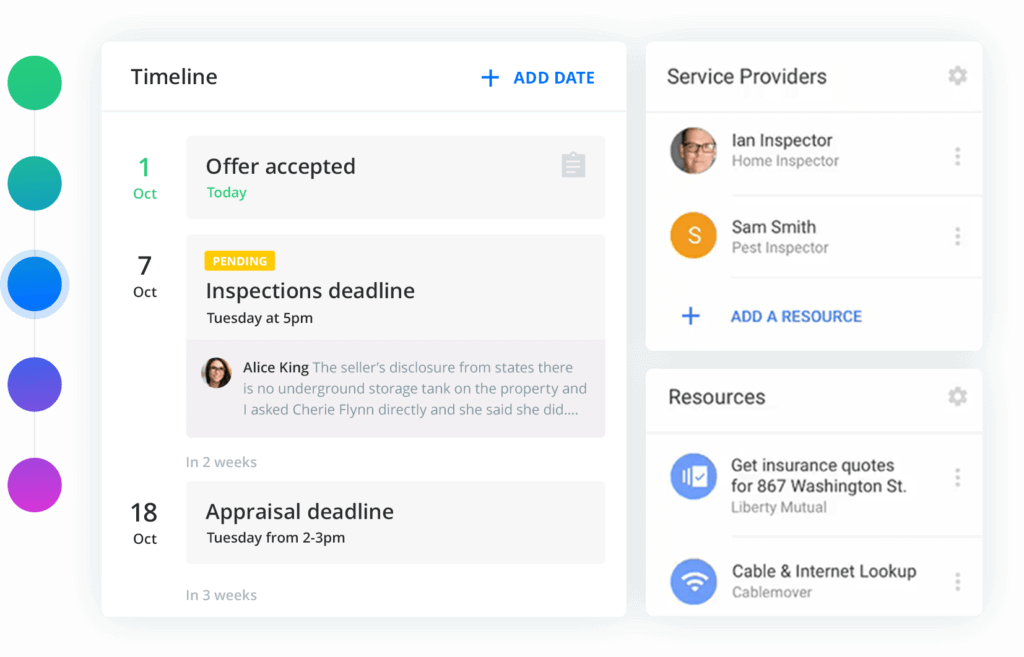
Overview
- Washington state’s escrow process is similar to other states where an escrow agent is used to complete the transaction.
- The buyer’s funds are held by a neutral third party, as is the purchase contract until an escrow agent verifies that both parties have performed their roles in the transaction
- The escrow company will notify the seller’s agent when the title has recorded, and the seller’s agent will usually then deliver the keys to the buyer’s agent or the buyer.
Step by Step
Part 1: Disclosures, inspections and credits
These are the initial tasks once a buyer is in contract, and are most often done in parallel to Part 2: The mortgage process:
- An offer is accepted by the seller and a contract is signed. The escrow process begins.
- A deposit, called earnest money, is deposited with the seller’s real estate brokerage, an escrow company, or an attorney depending on the contract (never to the seller directly). Escrow companies are often part of a title company but work as separate divisions.
- The buyer reviews and signs off on any disclosures. These disclosures vary based on property type but often include things like known flaws with the property, prior improvements or repairs, and potential environmental hazards. Often, a disclosure package is provided by the seller well in advance. In some cases, these disclosures and known defects are disclosed prior to the offer being accepted. Sellers may see this as beneficial to themselves, and believe that buyers will build these pre-disclosed facts into the contract price (and thus sellers may be reluctant to provide any credits for these defects).
- The buyer elects to perform inspections on the property as agreed upon in the contract. These inspections must be completed by a certain date, which is called the inspection contingency date. The types of inspections vary by property type and situation (and locale), but most buyers have a general contractor inspection. If that inspector calls for more detailed investigation, additional inspections on roofs, chimneys, oil tanks, asbestos, lead paint, and sewer lines are can be some of the more specialized additional inspections that may be necessary.
- Based on the outcome of inspections, buyers may elect to ask the seller for repair work, closing cost credits, or a reduction in the sale price due to flaws that were uncovered. Sellers have three options: agree to all of the buyers’ requests, offer a modified solution back to the buyer, or decline to make any amends. In response, the buyer can continue to negotiate, accept the seller’s position, or in some cases, end the transaction and recoup their earnest money.
- The buyer removes or waives the inspection contingency by agreeing to a signed inspection response with the seller, or by failing to make an inspection response request to the seller before the inspection contingency date has passed.
Part 2: The mortgage process
or those borrowing to purchase their home, the mortgage process is usually the most stressful and opaque part of the transaction. It’s best to start as early as possible and be ready to produce lots of documentation. The following is the general process in Washington:
- A buyer submits a loan application to their lender, either directly or through a mortgage broker. See a sample Uniform Residential Loan Application used in Washington State.
- Within 3 days, the lender sends a “Good Faith Estimate,” or GFE, to the buyer that is a breakdown of estimated closing costs. The final costs are likely to deviate from this estimate. See a sample GFE at hud.gov.
- Before the buyer is ready to write an offer, a pre-qualification with a lender should be acquired. The buyer sends a series of personal financial disclosures to the lender. These vary by situation, but the most commonly requested documents are:
- Several months of statements for each bank account a borrower holds (including any investment accounts)
- Several months of statements for any outstanding loans, lines of credit, or other liabilities. This can also include documentation of rent payments.
- Up to two years of tax returns, released to the lender via an authorization submitted by the buyer using IRS form 4506-T.
- Recent pay stubs and contact information for each borrower’s employer. The number of pay stubs varies by situation.
- Any other disclosures that are material to a borrower’s financial situation. This includes but is not limited to marriage licenses, divorce settlements, child support, liens, bankruptcies, or judgments. If there’s something that affects how much money you have on hand that isn’t shown by simply looking at your salary, be prepared to document it.
- Explanation of any credit inquiries
- Substantiation of any large deposits or cash gifts that aren’t regular income. In some cases, a large cash gift may look similar to a personal loan by a friend or family member, and lenders will require gift letters from those that gave you the cash gift, stating that the gift was not a loan. They may also ask for itemized deposit slips.
The exact amount that triggers this requirement varies by the situation (for instance, a $1,000 cash gift may be material to a single borrower that makes $35,000/yr but may not be material to a borrower that makes $350,000/yr), so it’s good practice to ask your lender if you suspect you might have a material cash gift or large deposit – so you aren’t surprised by this at the last minute. - Repeated and updated documentation of any of the above. Keep in mind: to a lender, anything can happen to a borrower’s personal financial situation and credit during the escrow process. Thus, you may be asked more than once for the same type of document so that your lender has the most recent pay stubs, rent receipts, bank statements, or other disclosures that may change over time. Any material changes in these documents -or any element of your personal financial situation- may require the lender to reassess your eligibility for the loan for which you’ve applied.
- The lender renders an approval decision, and if approved, issues a pre-approval letter, stating its willingness to fund the mortgage provided certain conditions are met. These conditions usually include appraisal (so the lender can confirm that the property you’re buying isn’t worth far less than you’re paying) but will also generally include any material change in your situation -or the property- as initially disclosed to your lender. Upon final approval from the loan underwriter, a loan commitment letter will be issued.
- The financing contingency, or loan contingency in Washington is different than in many other states. A buyer’s financing contingency extends without an end date unless the buyer specifically waives it. The contract will state a timeline (often 30 days), after which the seller can request that the buyer waive the financing contingency. If the buyer waives the financing contingency, it is removed as of that date. If the buyer does not waive it, after 3 days the seller has the option of terminating the contract. The earnest money would be refunded to the buyer.
Buyers should remember that their financing contingency, and its protection of their earnest money, extends through closing, as long as they do not specifically waive it. To successfully use the financing contingency as a means to end a contract and recoup earnest money, a buyer must show that they applied for the loan within the proper timeline, made a good faith effort to obtain the loan, did not change any of the financing terms in the contract, and have a letter from their lender documenting these points. - An appraisal is ordered by the lender or mortgage broker via a central directory of appraisers (often called an Appraisal Management Company or AMC). Choosing a specific appraiser is not possible, but a mortgage broker can reject an appraiser and ask for a new one. If the appraisal comes in lower than the purchase price, the buyer delivers a Notice of Low Appraisal within 3 days to the seller.
The seller can either lower the price of the home, request a reappraisal or reconsideration at the seller’s expense, or reject the Notice of Low Appraisal. If the seller rejects the notice, the contract will be terminated and the earnest money will be refunded to the buyer UNLESS the buyer specifically waives the financing contingency within 3 days. In that case, the buyer could accept the purchase price and make the financing work at a lower appraised value, often meaning a larger down payment. - Homeowners’ insurance is purchased (or substantiated, if the property being purchased includes homeowners’ insurance as part of association fees or similar arrangements), and proof of homeowners’ insurance is submitted to the lender.
Tip: As this process can be long, arduous, seemingly arbitrary, and is often critical to your homebuying transaction, try to prepare these documents (or at least figure out how to prepare them) in advance.
Also, do not make any changes to your employment or credit until your transaction is complete (not just until you get a loan commitment letter). This means not switching employers even if it results in a higher income, as counterintuitive as that may sound. It also means not leasing or financing a car, opening a new credit card account, or anything else that can affect your credit report.
Part 3: The closing itself
The closing process itself can span a couple of days or even a week, and in contrast to attorney review states, the transaction is not consummated with all parties sitting at the same table. In Washington, an escrow state, closing consists of the following steps:
- A title search is run early in the purchase process to determine if there are any liens or assessments on the title. Provided the title is deemed ‘clear,’ title insurance is prepared and the closing proceeds as planned.
- A buyer’s lender sends final loan documents to the escrow agent
- The buyer signs all closing documents, including the HUD-1 (see a sample HUD-1 here), and the final loan documents. This can happen at the escrow office, or at another location through a mobile notary service. The buyer needs to have a picture ID for the notary at the appointment.
- The seller signs a set of closing documents at a separate appointment, and often on a different date.
- The buyer deposits the remaining funds for their downpayment and closing costs to the escrow agent (either via cashier’s check or wire transfer)
- The escrow agent delivers the signed loan documents to the lender.
- The lender reviews the signed closing documents and wires the loan amount to the escrow agent. This can take 24-48 hours in some cases.
- The escrow agent records the deed with the appropriate municipality.
- When recording numbers come back from the municipality, the buyer receives the keys and, unless indicated differently in the contract, officially takes possession of the property.
Tip: Try to control for any surprises that may come up at the time of closing. Plan on signing loan documents a few days early if possible, and heed the advice not to materially change your employment or credit before closing.
Who we are
We've built Folio: the first AI email assistant for professionals.
Folio plugs directly into your work email inbox and automatically organizes your email, giving you contextual access to all the information you need to increase your productivity in minutes.
We are a team of passionate product people and engineers that gets excited about solving complex processes and creating value for people.
We're a venture funded company backed by Accel Partners, Vertical Venture Partners, and other leading venture capital firms and angel investors such as Ash Patel and Jerry Yang.

